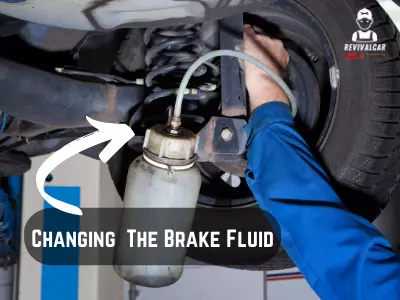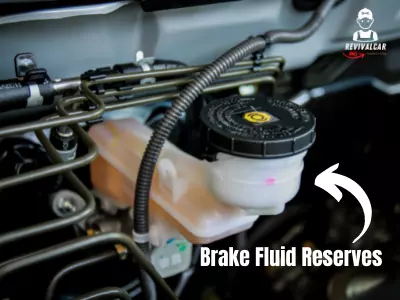First, you need to know what brake fluid. It is kind of a liquid that works on the hydraulics and creates pressure that transfers from brake pedals to the wheels or brake pads. It’s an intricate liquid and must be pressurized to make your vehicle work perfectly.
So knowing how to add brake fluid to your car is very important for any automobile user. The vehicle’s braking system works on pressure and is sealed; it must be kept in pristine shape to keep the car brake working. Brake fluid deteriorates and contaminates, so it needs to be replaced frequently.
We have written this article to give you a gist of how to do it right.
Understanding your cars braking Fluid system
It’s not just you keep your feet on the pedal, and the car brakes to a halt. There is more to it that goes inside the interior. Brake fluids play a crucial role in keeping your car functioning adequately. When you step on the pedals, the cylinder transfers the liquid to each wheel and applies pressure to make the car stop.
Testing your brakes and when do you need to change the fluid?
Take your car on a ride. If it’s a new one, test drive it and ensure every bit it is working precisely. The braking is smooth and has to be smooth as butter when pushed on the peddle. If you see some mishaps, there needs to be some work done. This is when you realize that some parts or even the brake fluid need to be replaced.

Diagnosing the bad brakes
A few basic symptoms will surely point out that your vehicle brakes lines are impaired. You can realize this through many signs or call it seeable pointers. We will talk about it now. A few things can point you that the fluids or parts need to be changed. Once you observe it, get it replaced ASAP.
Burning smell
Smells emitting from car wheels are expected. The moment you observe it, it’s time to take your vehicle to the mechanics. Brake fluids overheating is a traumatic experience for your car. It can severely damage everything. So always keep your nose open to burning odours.
Wearing brake pads
Brake pads deteriorate over time. You may find it hard to push on it or feel the jammed bit. Worn-out brake pads will make noises for sure. You get the cue that something is worn and needs to be looked after.
Noise when braking
When brake fluid runs low or gets burned, you can hear noises while slowing down. It is normal. Take it to a mechanic shop if this happens. Your brake shoes or brake pads might need a change. Even the fluids might need a replacement. Get it done immediately if you hear screeches, grinding, or squealing.
ABS light signal
On your RPM, you can observe the ABS light signaling if there is any problem with the braking system. Yes, technology is now very advanced. It can figure out problems without you doing it manually. But we prefer you always keep your eyes and nose on to work for any kind of brake problems. ABS light flashes when brake fluids are imperiled. Do check on it. Don’t just keep your eyes on the road. Keep your eyes everywhere.
Unresponsive pedals
Brake pads are a bit rigid to push on. It’s normal. If you feel it’s too loose, the fluid might be running low. Another thing is if you observe the pads are too tight, then there is a problem too. There might be some kind of impairment and fluid deterioration that’s making it happen. GO to a car mechanic if you are not an expert.
How often does brake fluid need to be replaced?
Go to a mechanic, and they will guide you on what needs to be done or changed. Most car owners do the fluid change in four to five years. That doesn’t mean it can hamper your braking system before that period. You may need a change within a year if you observe the abovementioned problems.
What happens when brake fluid is low?
You already have your answer. Your pedals will be loose, and most importantly, your car brakes will not work. You might observe no stopping power while trying to push on the pedal. Low fluid will make the pedals feel soft and squishy. And it’s dangerous while driving. Get it checked. Stop immediately.
How do I know what braking fluid to use?
Check your car’s owner manual, and it will tell you what needs to be put into it. Also, check the master cylinder. It should point out the type your car deserves.
Add Brake Fluid To A Vehicle Step by Step
Brake fluid is an imperative factor in your car’s brake system, but you may not know how to change it. You want to make sure that you’re doing it properly, so you don’t break your car. You can always follow the guide below to change your brake fluid, but if you’re in any doubt, read the video below to understand more about the process

Step 1:Park your car on a level and safe surface
You must keep your car in a safe place before applying brake fluids. Keep it stationary so you can read the fluid levels.
Step 2: Push/Depress the pedals.
Before any work is done, you must depress your brake pedals at least 30 to 40 times. Make it easy to maneuver.
Step 3: Find the location of the fluid reservoir.
Open the hood, and the compartment should be on the back of the engine, the bottom of the windshield. Best if you observe the manual, you will get the exact location.
Step 4: Observe the fluid.
Compartments are made of plastic, and you can easily see the fluid levels. There is nothing to explain further about this issue.
Step 5: Check the level marker
Observe the level marker that shows low marks as minimum and maximum. If it’s minimum, you need to change the fluids.
Step 6: Check the color of the fluid
Damaged fluid will be dark or brown. Normal and healthy fluid is yellowish and golden. If you witness too dark of a liquid, then a change is needed.
Step 7: Clean the compartment of the fluid
Turn the car power off. Then take a rag and clean the inside of the compartment with the cloth. Make sure there is no debris or contaminants in there.
Step 8: Add the fluid
This is what you’ve been waiting for. Check the instruction manual first. Be sure the car maker approves the brake fluid. You must know what fluid to use. Use a funnel and fill up the container until it reaches the maximum level mark. That’s it.
Step 9: You’re done, put the caps and PUMP the brakes.
Time to reinstall the container cap and go to your car. Start the engine. Pump the brakes at least 30 to 40 times. It will ease off the pedals and prime the liquid for sure. Now have a drive and see how it feels.
Do you need to bleed the fluid?
No, if the color is standard. You can simply add extra fluid without worrying. But if the colour is darker and the fluid is damaged, just like step 6, then you need to drain the fluid (bleed). Then clean the compartment and fill it up with new fluid as mentioned in the steps above.
More Resources About Brake Fluid
Final Verdict for Add Brake Fluid
Brake fluids are pivotal for any automobile user. YOu cannot overlook it. If the fluid levels run low or deteriorate, you are doomed. Your car won’t be working smoothly and might not halt when necessary, causing accidents.
So, check out this article and know how to add brake fluid to a car to ensure you are safe while driving. Driving is fun and exhilarating, don’t make it a disaster by overlooking the simple things like brake fluid. Have a safe ride wherever you are.




